Low-Threshold, Multiple High-Order Harmonics Fiber Laser Employing Cr2Si2Te6 Saturable Absorber
Abstract
1. Introduction
2. Preparation and Characteristics of the Cr2Si2Te6-Based SA
3. Results and Discussion
4. Conclusions
Author Contributions
Funding
Data Availability Statement
Conflicts of Interest
References
- Turunen, M.; Brotons-Gisbert, M.; Dai, Y.Y.; Wang, Y.D.; Scerri, E.; Bonato, C.; Jöns, K.D.; Sun, Z.P.; Gerardot, B.D. Quantum photonics with layered 2D materials. Nat. Rev. Phys. 2022, 4, 219–236. [Google Scholar]
- Zeng, L.H.; Wu, D.; Jie, J.S.; Ren, X.Y.; Hu, X.; Lau, S.P.; Chai, Y.; Tsang, Y.H. Van der Waals epitaxial growth of mosaic-like 2D platinum ditelluride layers for room-temperature mid-infrared photodetection up to 10.6 µm. Adv. Mater. 2020, 32, 2004412. [Google Scholar] [CrossRef] [PubMed]
- Wu, D.; Guo, J.W.; Wang, C.Q.; Ren, X.Y.; Chen, Y.S.; Lin, P.; Zeng, L.H.; Shi, Z.F.; Li, X.J.; Shan, C.X.; et al. Ultrabroadband and high-detectivity photodetector based on WS2/Ge heterojunction through defect engineering and interface passivation. ACS Nano 2021, 15, 10119–10129. [Google Scholar] [CrossRef]
- Ge, X.X.; Xia, Z.H.; Guo, S.J. Recent advances on black phosphorus for biomedicine and biosensing. Adv. Funct. Mater. 2019, 29, 1900318. [Google Scholar] [CrossRef]
- Glavin, N.R.; Rao, R.; Varshney, V.; Bianco, E.; Apte, A.; Roy, A.; Ringe, E.; Ajayan, P.M. Emerging applications of elemental 2D materials. Adv. Mater. 2020, 32, 1904302. [Google Scholar] [CrossRef]
- Wu, D.; Xu, M.M.; Zeng, L.H.; Shi, Z.F.; Tian, Y.Z.; Li, X.J.; Shan, C.X.; Jie, J.S. In Situ Fabrication of PdSe2/GaN Schottky Junction for Polarization-Sensitive Ultraviolet Photodetection with High Dichroic Ratio. ACS Nano 2022, 16, 5545–5555. [Google Scholar] [CrossRef] [PubMed]
- Zeng, L.H.; Wu, D.; Lin, S.H.; Xie, C.; Yuan, H.Y.; Lu, W.; Lau, S.P.; Chai, Y.; Luo, L.B.; Li, Z.J.; et al. Controlled synthesis of 2D palladium diselenide for sensitive photodetector applications. Adv. Funct. Mater. 2019, 29, 1806878. [Google Scholar] [CrossRef]
- Liu, W.J.; Liu, M.L.; Liu, X.M.; Wang, X.T.; Deng, H.X.; Lei, M.; Wei, Z.M.; Wei, Z.Y. Recent advances of 2D materials in nonlinear photonics and fiber lasers. Adv. Opt. Mater. 2020, 8, 1901631. [Google Scholar] [CrossRef]
- He, J.S.; Tao, L.L.; Zhang, H.; Zhou, B.; Li, J.B. Emerging 2D materials beyond graphene for ultrashort pulse generation in fiber lasers. Nanoscale 2019, 11, 2577–2593. [Google Scholar] [CrossRef]
- Yu, S.L.; Wu, X.Q.; Wang, Y.P.; Guo, X.; Tong, L.M. 2D materials for optical modulation: Challenges and opportunities. Adv. Mater. 2017, 29, 1606128. [Google Scholar] [CrossRef]
- Fu, B.; Sun, J.X.; Wang, G.; Shang, C.; Ma, Y.X.; Ma, J.G.; Xu, L.J.; Scardaci, V. Solution-processed two-dimensional materials for ultrafast fiber lasers. Nanophotonics 2020, 9, 2169–2189. [Google Scholar] [CrossRef]
- Yamashita, S. Nonlinear optics in carbon nanotube, graphene, and related 2D materials. APL Photonics 2019, 4, 034301. [Google Scholar] [CrossRef]
- Zhang, H.N.; Sun, S.; Shang, X.X.; Guo, B.; Li, X.H.; Chen, X.H.; Jiang, S.Z.; Zhang, H.; Ågren, H.; Zhang, W.F.; et al. Ultrafast photonics applications of emerging 2D-Xenes beyond graphene. Nanophotonics 2022, 11, 1261–1284. [Google Scholar] [CrossRef]
- Jiang, T.; Yin, K.; Wang, C.; You, J.; Ouyang, H.; Miao, R.L.; Zhang, C.X.; Wei, K.; Li, H.; Chen, H.T.; et al. Ultrafast fiber lasers mode-locked by two-dimensional materials: Review and prospect. Photonics Res. 2020, 8, 78–90. [Google Scholar] [CrossRef]
- Nakazawa, M.; Yoshida, E.; Kimura, Y. Low threshold, 290 fs erbium-doped fiber laser with a nonlinear amplifying loop mirror pumped by InGaAsP laser diodes. Appl. Phys. Lett. 1991, 59, 2073–2075. [Google Scholar] [CrossRef]
- Mondal, S.; Ganguly, R.; Mondal, K. Topological Insulators: An In-Depth Review of Their Use in Modelocked Fiber Lasers. Ann. Phys. 2021, 533, 2000564. [Google Scholar] [CrossRef]
- Yusoff, N.M.; Abdullah, C.A.C.; Hadi, M.A.; Ng, E.K.; Lee, H.K.; Abidin, N.Z.; Rosli, N.S.; Mahdi, M.A. Low threshold Q-switched fiber laser incorporating titanium dioxide saturable absorber from waste material. Optik 2020, 218, 164998. [Google Scholar] [CrossRef]
- Lü, B.; Rudolph, W.; Weber, H. Statistics of mode-locking threshold. Opt. Commun. 1985, 53, 203–209. [Google Scholar] [CrossRef]
- Li, L.; Pang, L.H.; Zhao, Q.Y.; Wang, Y.G.; Liu, W.J. Niobium disulfide as a new saturable absorber for an ultrafast fiber laser. Nanoscale 2020, 12, 4537–4543. [Google Scholar] [CrossRef]
- Sun, S.; Yang, F.H.; Sui, Z.Q.; Zhu, M.X.; Chen, S.; Wang, Y.J.; Hong, Z.F.; Zhang, W.F.; Fu, S.G.; Chen, X.H.; et al. Demonstration of passively Q-switched and mode-locked operations through dispersion control in Er-doped fiber lasers with a cylindrite-based saturable absorber. J. Lumin. 2022, 250, 119064. [Google Scholar] [CrossRef]
- Xu, N.N.; Ma, P.F.; Fu, S.G.; Shang, X.X.; Jiang, S.Z.; Wang, S.Y.; Li, D.W.; Zhang, H.N. Tellurene-based saturable absorber to demonstrate large-energy dissipative soliton and noise-like pulse generations. Nanophotonics 2020, 9, 2783–2795. [Google Scholar] [CrossRef]
- Gao, Q.; Yang, H.; Hu, C.; He, Z.W.; Lu, H.; Zhang, W.D.; Mao, D.; Mei, T.; Zhao, J.L. Physical vapor deposition of large-scale PbSe films and its applications in pulsed fiber lasers. Nanophotonics 2020, 9, 2367–2375. [Google Scholar] [CrossRef]
- Liu, W.J.; Liu, M.L.; Chen, X.; Shen, T.; Lei, M.; Guo, J.G.; Deng, H.X.; Zhang, W.; Dai, C.Q.; Zhang, X.F.; et al. Ultrafast photonics of two dimensional AuTe2Se4/3 in fiber lasers. Commun. Phys. 2020, 3, 15. [Google Scholar] [CrossRef]
- Liu, M.L.; Wu, H.B.; Liu, X.M.; Wang, Y.R.; Lei, M.; Liu, W.J.; Guo, W.; Wei, Z.Y. Optical properties and applications of SnS2 SAs with different thickness. Opto-Electron. Adv. 2021, 4, 200029-1. [Google Scholar] [CrossRef]
- Yan, P.G.; Lin, R.Y.; Ruan, S.C.; Liu, A.J.; Chen, H.; Zheng, Y.Q.; Chen, S.F.; Guo, C.Y.; Hu, J.G. A practical topological insulator saturable absorber for mode-locked fiber laser. Sci. Rep. 2015, 5, 8690. [Google Scholar] [CrossRef]
- Wang, Z.H.; Li, C.Y.; Ye, J.W.; Wang, Z.; Liu, Y.G. Generation of harmonic mode-locking of bound solitons in the ultrafast fiber laser with Sb2Te3 saturable absorber on microfiber. Laser. Phys. Lett. 2019, 16, 025103. [Google Scholar] [CrossRef]
- Liu, W.J.; Xiong, X.L.; Liu, M.L.; Xing, X.W.; Chen, H.L.; Ye, H.; Han, J.F.; Wei, Z.Y. Bi4Br4-based saturable absorber with robustness at high power for ultrafast photonic device. Appl. Phys. Lett. 2022, 120, 053108. [Google Scholar] [CrossRef]
- Yin, K.; Zhang, B.; Li, L.; Jiang, T.; Zhou, X.F.; Hou, J. Soliton mode-locked fiber laser based on topological insulator Bi2Te3 nanosheets at 2 μm. Photonics Res. 2015, 3, 72–76. [Google Scholar] [CrossRef]
- Liu, X.; Gao, Q.; Zheng, Y.; Mao, D.; Zhao, J.L. Recent progress of pulsed fiber lasers based on transition-metal dichalcogenides and black phosphorus saturable absorbers. Nanophotonics 2020, 9, 2215–2231. [Google Scholar] [CrossRef]
- Zhang, M.; Wu, Q.; Zhang, F.; Chen, L.L.; Jin, X.X.; Hu, Y.W.; Zheng, Z.; Zhang, H. 2D black phosphorus saturable absorbers for ultrafast photonics. Adv. Opt. Mater. 2019, 7, 1800224. [Google Scholar] [CrossRef]
- Yu, H.; Zheng, X.; Yin, K.; Chen, X.A.; Jiang, T. Thulium/holmium-doped fiber laser passively mode locked by black phosphorus nanoplatelets-based saturable absorber. Appl. Opt. 2015, 54, 10290–10294. [Google Scholar] [CrossRef] [PubMed]
- Xu, N.N.; Wang, H.F.; Zhang, H.N.; Guo, L.G.; Shang, X.X.; Jiang, S.Z.; Li, D.W. Palladium diselenide as a direct absorption saturable absorber for ultrafast mode-locked operations: From all anomalous dispersion to all normal dispersion. Nanophotonics 2020, 9, 4295–4306. [Google Scholar] [CrossRef]
- Shang, X.X.; Xu, N.N.; Zhang, H.N.; Li, D.W. Nonlinear photoresponse of high damage threshold titanium disulfide nanocrystals for Q-switched pulse generation. Opt. Laser. Technol. 2022, 151, 107988. [Google Scholar] [CrossRef]
- Lee, J.; Koo, J.; Lee, J.; Jhon, Y.M.; Lee, J.H. All-fiberized, femtosecond laser at 1912 nm using a bulk-like MoSe2 saturable absorber. Opt. Mater. Express 2017, 7, 2968–2979. [Google Scholar] [CrossRef]
- Wu, K.; Zhang, X.Y.; Wang, J.; Li, X.; Chen, J.P. WS2 as a saturable absorber for ultrafast photonic applications of mode-locked and Q-switched lasers. Opt. Express 2015, 23, 11453–11461. [Google Scholar] [CrossRef]
- Liu, G.W.; Zhang, F.; Wu, T.G.; Li, Z.W.; Zhang, W.F.; Han, K.Z.; Xing, F.; Man, Z.S.; Ge, X.L.; Fu, S.G. Single-and dual-wavelength passively mode-locked erbium-doped fiber laser based on antimonene saturable absorber. IEEE Photon. J. 2019, 11, 1–11. [Google Scholar] [CrossRef]
- Guo, B.; Wang, S.H.; Wu, Z.X.; Wang, Z.X.; Wang, D.H.; Huang, H.; Zhang, F.; Ge, Y.Q.; Zhang, H. Sub-200 fs soliton mode-locked fiber laser based on bismuthene saturable absorber. Opt. Express 2018, 26, 22750–22760. [Google Scholar] [CrossRef]
- Huang, W.C.; Ma, C.Y.; Li, C.; Zhang, Y.; Hu, L.P.; Chen, T.T.; Tang, Y.F.; Jun, J.F.; Zhang, H. Highly stable MXene (V2CTx)-based harmonic pulse generation. Nanophotonics 2020, 9, 2577–2585. [Google Scholar] [CrossRef]
- Gao, L.F.; Ma, C.Y.; Wei, S.R.; Kuklin, A.V.; Zhang, H.; Ågren, H. Applications of few-layer Nb2C MXene: Narrow-band photodetectors and femtosecond mode-locked fiber lasers. ACS Nano 2021, 15, 954–965. [Google Scholar] [CrossRef]
- Ouvrard, G.; Sandre, E.; Brec, R. Synthesis and crystal structure of a new layered phase: The chromium hexatellurosilicate Cr2Si2Te6. J. Solid State Chem. 1988, 73, 27–32. [Google Scholar] [CrossRef]
- Liu, X.; Wang, Z.Y.; Liu, D.Y.; Zou, L.J. Enhancement of Curie temperature and reorientation of spin in doped Cr2Si2Te6. AIP Adv. 2021, 11, 095002. [Google Scholar] [CrossRef]
- Hong, Z.F.; Jiang, X.W.; Zhang, M.X.; Zhang, H.N.; Liu, X.J. High Power and Large-Energy Pulse Generation in an Erbium-Doped Fiber Laser by a Ferromagnetic Insulator-Cr2Si2Te6 Saturable Absorber. Nanomaterials 2022, 12, 564. [Google Scholar] [CrossRef] [PubMed]
- Xu, N.N.; Sun, S.; Shang, X.X.; Zhang, H.N.; Li, D.W. Harmonic and fundamental-frequency mode-locked operations in an Er-doped fiber laser using a Cr2Si2Te6-based saturable absorber. Opt. Mater. Express 2022, 12, 166–173. [Google Scholar] [CrossRef]
- Liu, Y.; Susilo, R.A.; Lee, Y.; Abeykoon, A.M.; Tong, X.; Hu, Z.X.; Stavitski, E.; Attenkofer, K.; Ke, L.Q.; Chen, B.; et al. Short-Range Crystalline Order-Tuned Conductivity in Cr2Si2Te6 van der Waals Magnetic Crystals. ACS Nano 2022, 16, 13134–13143. [Google Scholar] [CrossRef]
- Zhao, H.D.; Ni, Y.F.; Hu, B.; Selter, S.; Aswartham, S.; Zhang, Y.; Büchner, B.; Schlottmann, P.; Cao, G. Mechanical control of physical properties in the van der Waals ferromagnet Cr2Ge2Te6 via application of electric current. arXiv 2022, arXiv:2201.08509. [Google Scholar] [CrossRef]
- Kang, S.; Kang, S.; Kim, H.S.; Yu, J. Field-controlled quantum anomalous Hall effect in electron-doped CrSiTe3 monolayer: A first-principles prediction. arXiv 2022, arXiv:2208.02997. [Google Scholar]
- Cai, W.P.; Sun, H.L.; Xia, W.; Wu, C.W.; Liu, Y.; Liu, H.; Gong, Y.; Yao, D.X.; Guo, Y.F.; Wang, M. Pressure-induced superconductivity and structural transition in ferromagnetic CrSiTe3. Phys. Rev. B 2020, 102, 144525. [Google Scholar] [CrossRef]
- Baranava, M.S.; Hvazdouski, D.C.; Skachkova, V.A.; Stempitsky, V.R.; Danilyuk, A.L. Magnetic interactions in Cr2Ge2Te6 and Cr2Si2Te6 monolayers: Ab initio study. Mater. Today Proc. 2020, 20, 342–347. [Google Scholar] [CrossRef]
- Carteaux, V.; Brunet, D.; Ouvrard, G.; Andre, G. Crystallographic, magnetic and electronic structures of a new layered ferromagnetic compound Cr2Ge2Te6. J. Phys. Condens. Matter. 1995, 7, 69. [Google Scholar] [CrossRef]
- Milosavljević, A.; Šolajić, A.; Pešić, J.; Liu, Y.; Petrovic, C.; Lazarević, N.; Popović, Z.V. Evidence of spin-phonon coupling in CrSiTe3. Phys. Rev. B 2018, 98, 104306. [Google Scholar] [CrossRef]
- Liu, X.; Pang, M. Revealing the buildup dynamics of harmonic mode-locking states in ultrafast lasers. Laser. Photonics Rev. 2019, 13, 1800333. [Google Scholar] [CrossRef]
- Fu, B.; Hua, Y.; Xiao, X.S.; Zhu, H.W.; Sun, Z.P.; Yang, C.Y. Broadband graphene saturable absorber for pulsed fiber lasers at 1, 1.5, and 2 μm. IEEE J. Sel. Top. Quantum Electron. 2014, 20, 411–415. [Google Scholar]
- Sobon, G.; Sotor, J.; Abramski, K.M. All-polarization maintaining femtosecond Er-doped fiber laser mode-locked by graphene saturable absorber. Laser. Phys. Lett. 2012, 9, 581. [Google Scholar] [CrossRef]
- Duan, L.N.; Wang, Y.G.; Xu, C.W.; Li, L.; Wang, Y.S. Passively Harmonic Mode-Locked Fiber Laser With a High Signal-to-Noise Ratio via Evanescent-Light Deposition of Bismuth Telluride Bi2Te3 Topological Insulator Based Saturable Absorber. IEEE Photon. J. 2015, 7, 1–7. [Google Scholar] [CrossRef]
- Zhao, C.J.; Zou, Y.H.; Chen, Y.; Wang, Z.T.; Lu, S.B.; Zhang, H.; Wen, S.C.; Tang, D.Y. Wavelength-tunable picosecond soliton fiber laser with topological insulator: Bi2Se3 as a mode locker. Opt. Express 2012, 20, 27888–27895. [Google Scholar] [CrossRef]
- Boguslawski, J.; Sotor, J.; Sobon, G.; Tarka, J.; Jagiello, J.; Macherzynski, W.; Lipinska, L.; Abramski, K.M. Mode-locked Er-doped fiber laser based on liquid phase exfoliated Sb2Te3 topological insulator. Laser. Phys. 2014, 24, 105111. [Google Scholar] [CrossRef]
- Sotor, J.; Sobon, G.; Macherzynski, W.; Paletko, P.; Abramski, K.M. Black phosphorus saturable absorber for ultrashort pulse generation. Appl. Phys. Lett. 2015, 107, 051108. [Google Scholar] [CrossRef]
- Luo, Z.C.; Liu, M.; Guo, Z.N.; Jiang, X.F.; Luo, A.P.; Zhao, C.J.; Yu, X.F.; Xu, W.C.; Zhang, H. Microfiber-based few-layer black phosphorus saturable absorber for ultra-fast fiber laser. Opt. Express 2015, 23, 20030–20039. [Google Scholar] [CrossRef]
- Chen, H.; Li, L.; Ruan, S.C.; Guo, T.; Yan, P.G. Fiber-integrated tungsten disulfide saturable absorber (mirror) for pulsed fiber lasers. Opt. Eng. 2016, 55, 081318. [Google Scholar] [CrossRef]
- Jiang, Z.K.; Chen, H.; Li, J.R.; Yin, J.D.; Wang, J.Z.; Yan, P.G. 256 fs, 2 nJ soliton pulse generation from MoS2 mode-locked fiber laser. Appl. Phys. Express 2017, 10, 122702. [Google Scholar] [CrossRef]
- Mao, D.; She, X.Y.; Du, B.B.; Yang, D.X.; Zhang, W.D.; Song, K.; Cui, X.Q.; Jiang, B.Q.; Peng, T.; Zhao, J.L. Erbium-doped fiber laser passively mode locked with few-layer WSe2/MoSe2 nanosheets. Sci. Rep. 2016, 6, 23583. [Google Scholar] [CrossRef] [PubMed]
- Zhang, R.L.; Wang, J.; Zhang, X.Y.; Lin, J.T.; Li, X.; Kuan, P.W.; Zhou, Y.; Liao, M.S.; Gao, W.Q. Mode-locked fiber laser with MoSe2 saturable absorber based on evanescent field. Chin. Phys. B 2019, 28, 014207. [Google Scholar] [CrossRef]
- Feng, J.J.; Li, X.H.; Feng, T.C.; Wang, Y.M.; Liu, J.; Zhang, H. Harmonic mode-locked Er-doped fiber laser by evanescent field-based MXene Ti3C2Tx (T= F, O, or OH) saturable absorber. Ann. Phys. 2020, 532, 1900437. [Google Scholar] [CrossRef]
- Lu, L.; Liang, Z.M.; Wu, L.M.; Chen, Y.X.; Song, Y.F.; Dhanabalan, S.C.; Ponraj, J.S.; Dong, B.Q.; Xiang, Y.J.; Xing, F.; et al. Few-layer bismuthene: Sonochemical exfoliation, nonlinear optics and applications for ultrafast photonics with enhanced stability. Laser. Photonics Rev. 2018, 12, 1700221. [Google Scholar] [CrossRef]
- Zhao, Z.H.; Jin, L.; Set, S.Y.; Yamashita, S.J. 2.5 GHz harmonic mode locking from a femtosecond Yb-doped fiber laser with high fundamental repetition rate. Opt. Lett. 2021, 46, 3621–3624. [Google Scholar] [CrossRef]
- Grelu, P.; Soto-Crespo, J.M. Multisoliton states and pulse fragmentation in a passively mode-locked fibre laser. J. Opt. B Quantum Semiclass. Opt. 2004, 6, S271. [Google Scholar] [CrossRef]
- Sulimany, K.; Lib, O.; Masri, G.; Klein, A.; Fridman, M.; Grelu, P.; Gat, O.; Steinberg, H. Bidirectional soliton rain dynamics induced by casimir-like interactions in a graphene mode-locked fiber laser. Phys. Rev. Lett. 2018, 121, 133902. [Google Scholar] [CrossRef]
- Grudinin, A.B.; Gray, S. Passive harmonic mode locking in soliton fiber lasers. JOSA B 1997, 14, 144–154. [Google Scholar] [CrossRef]
- Loh, W.H.; Grudinin, A.B.; Afanasjev, V.V.; Payne, D.N. Soliton interaction in the presence of a weak nonsoliton component. Opt. Lett. 1994, 19, 698–700. [Google Scholar] [CrossRef]
- Kutz, J.N.; Collings, B.C.; Bergman, K.; Knox, W.H. Stabilized pulse spacing in soliton lasers due to gain depletion and recovery. IEEE J. Quantum Electron. 1998, 34, 1749–1757. [Google Scholar] [CrossRef]

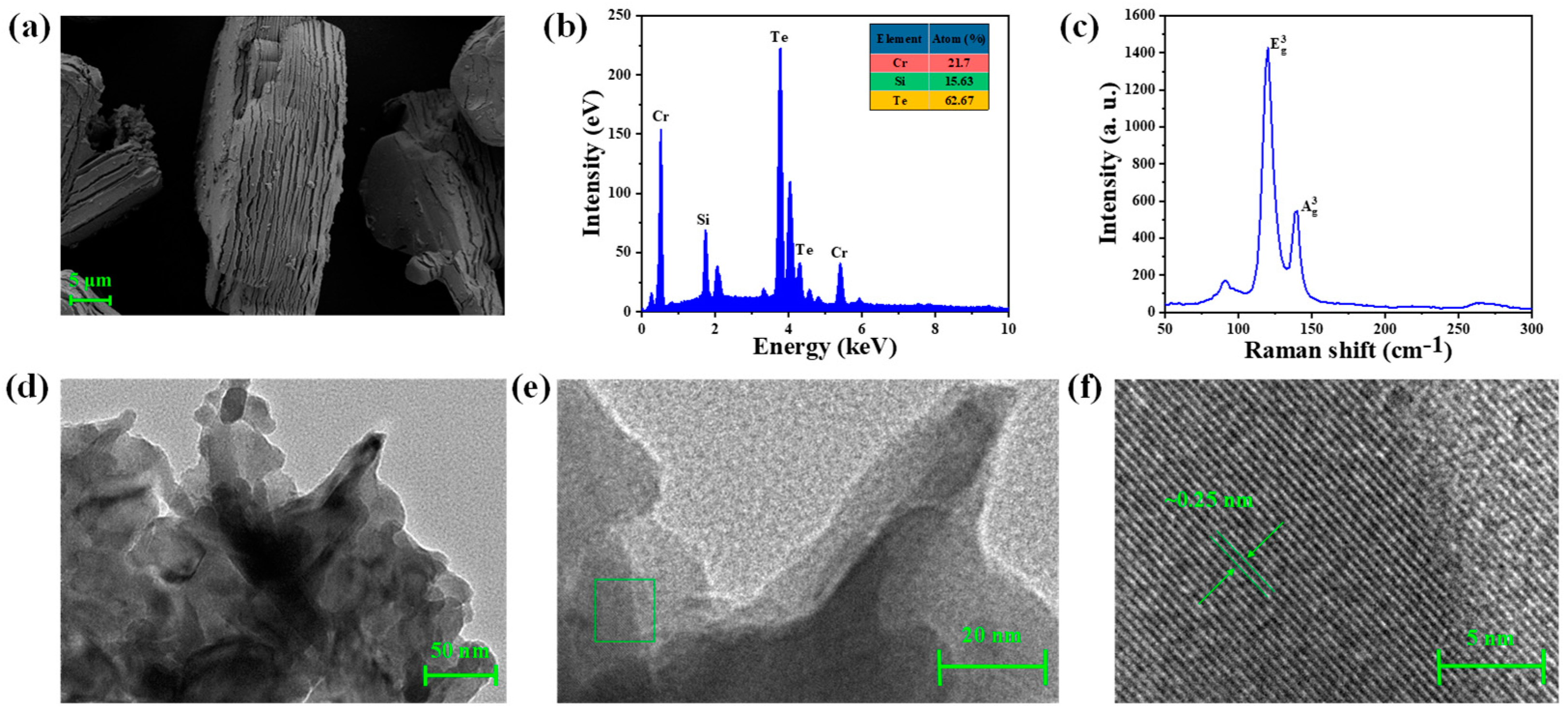
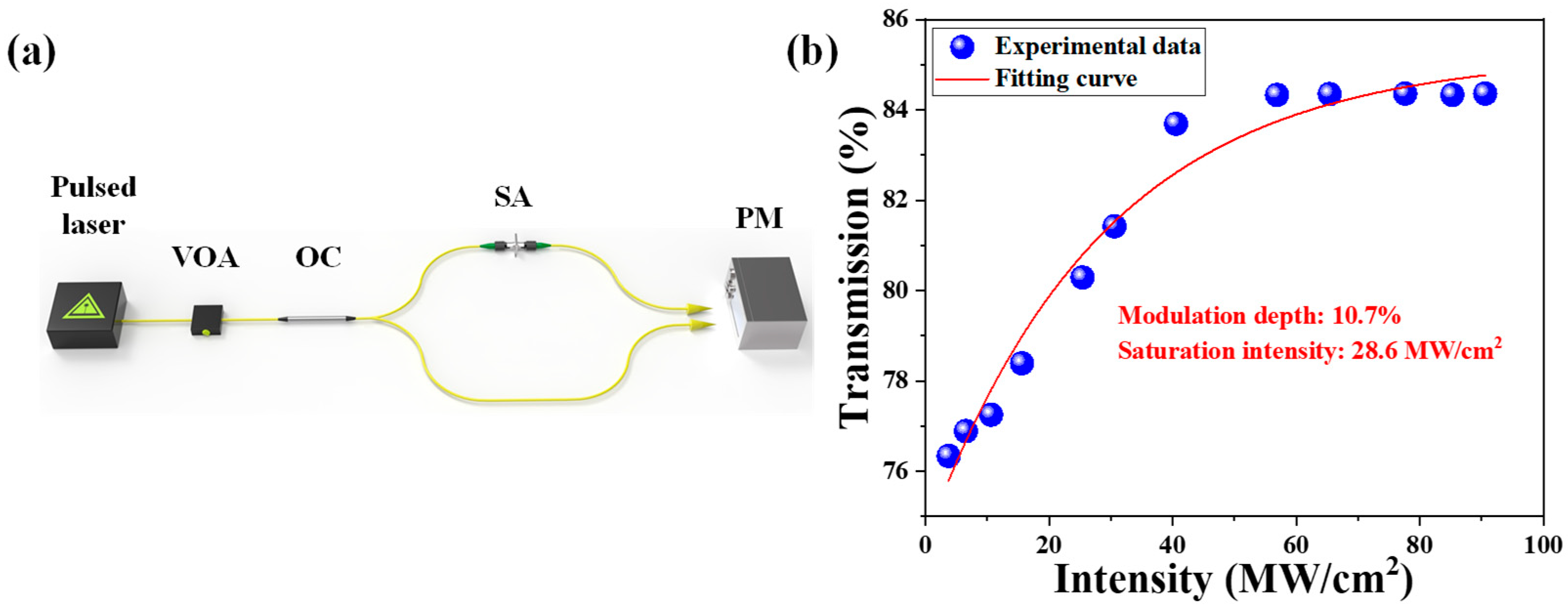
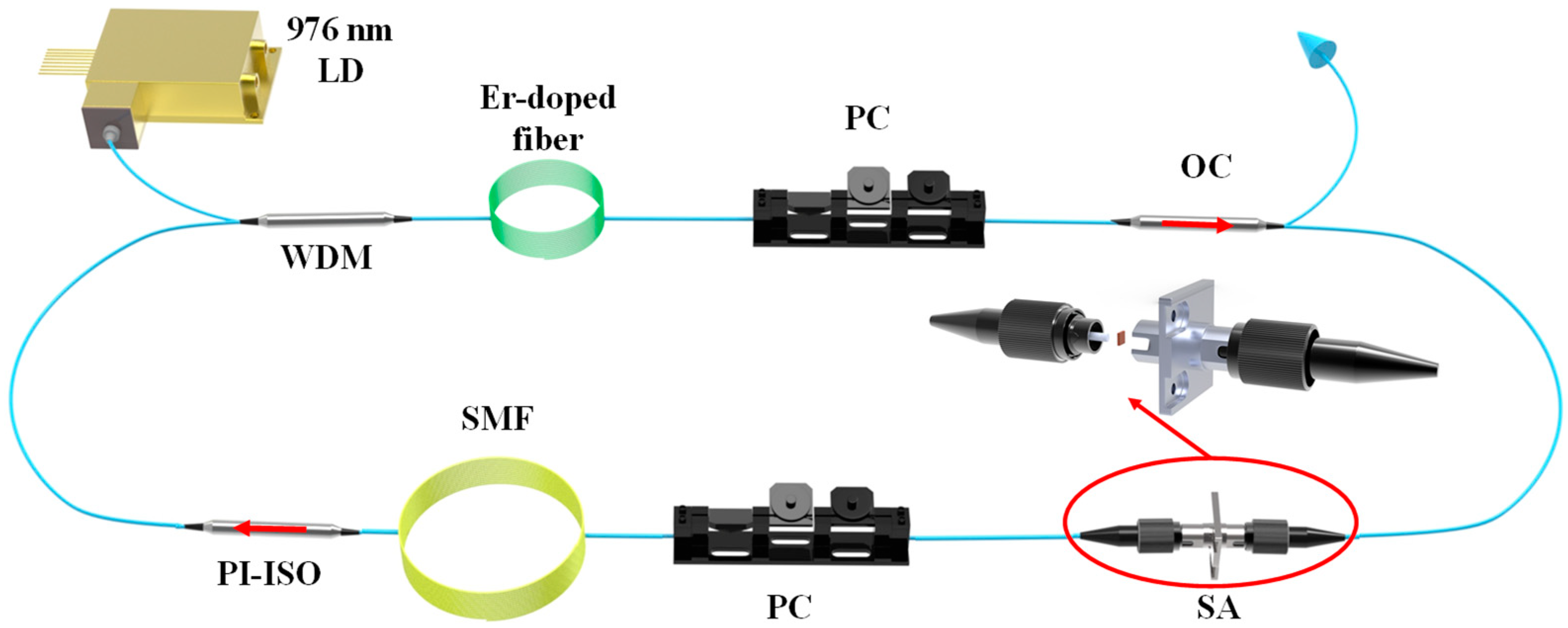
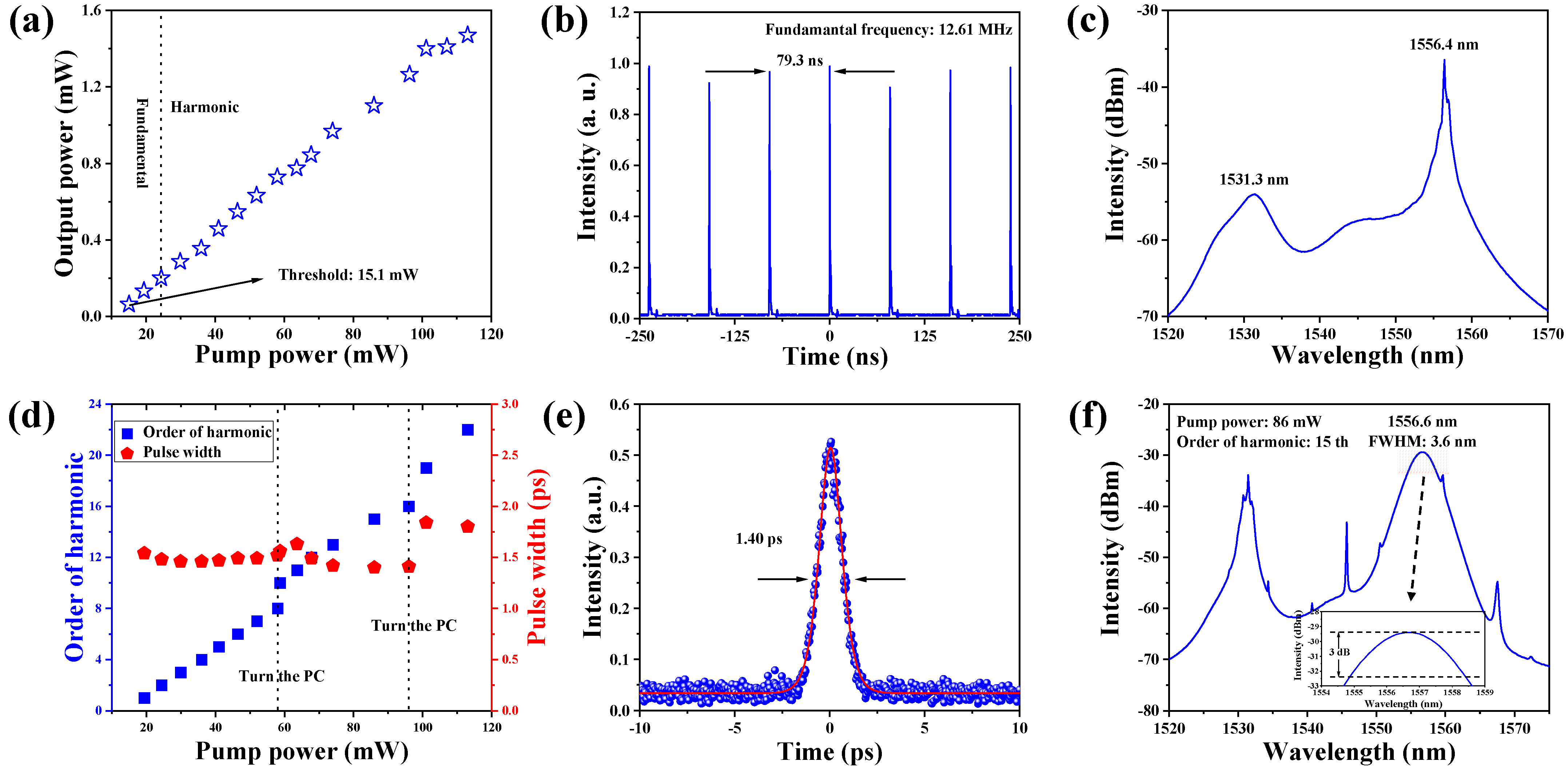
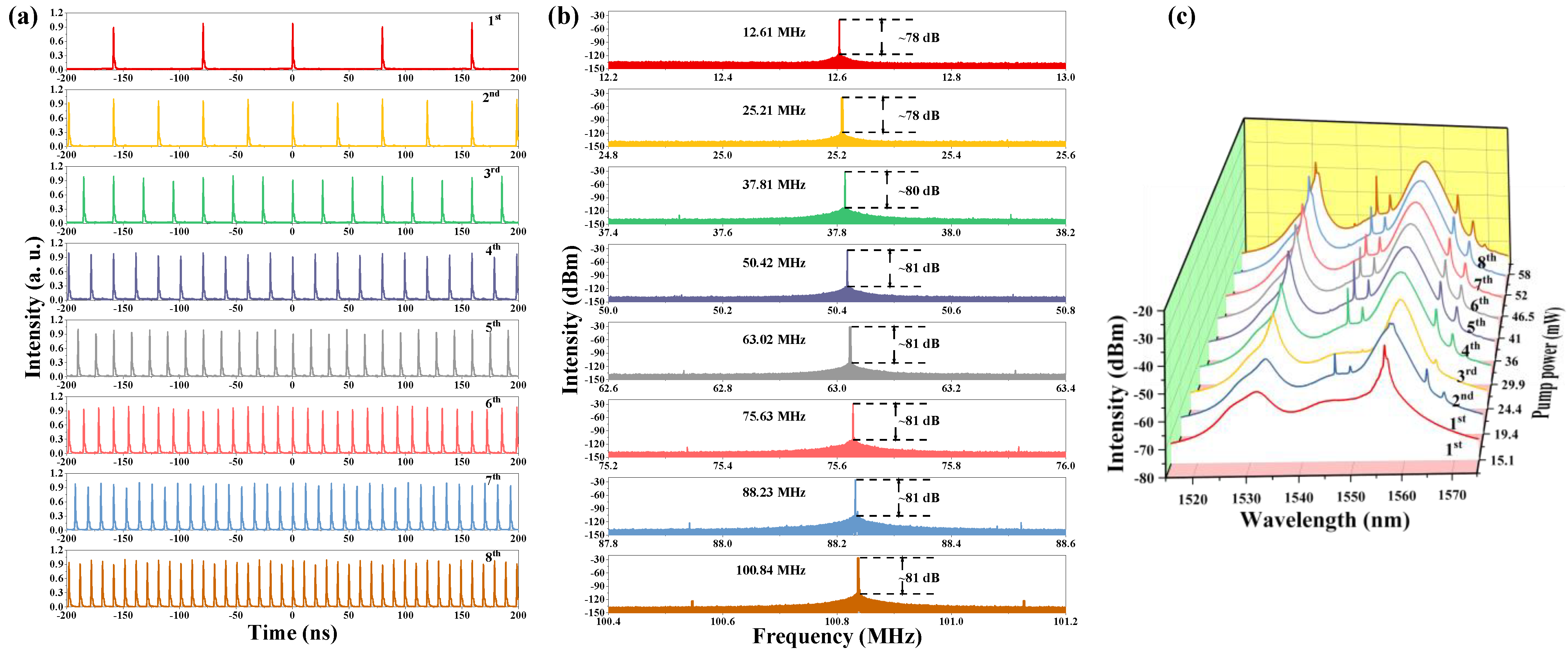
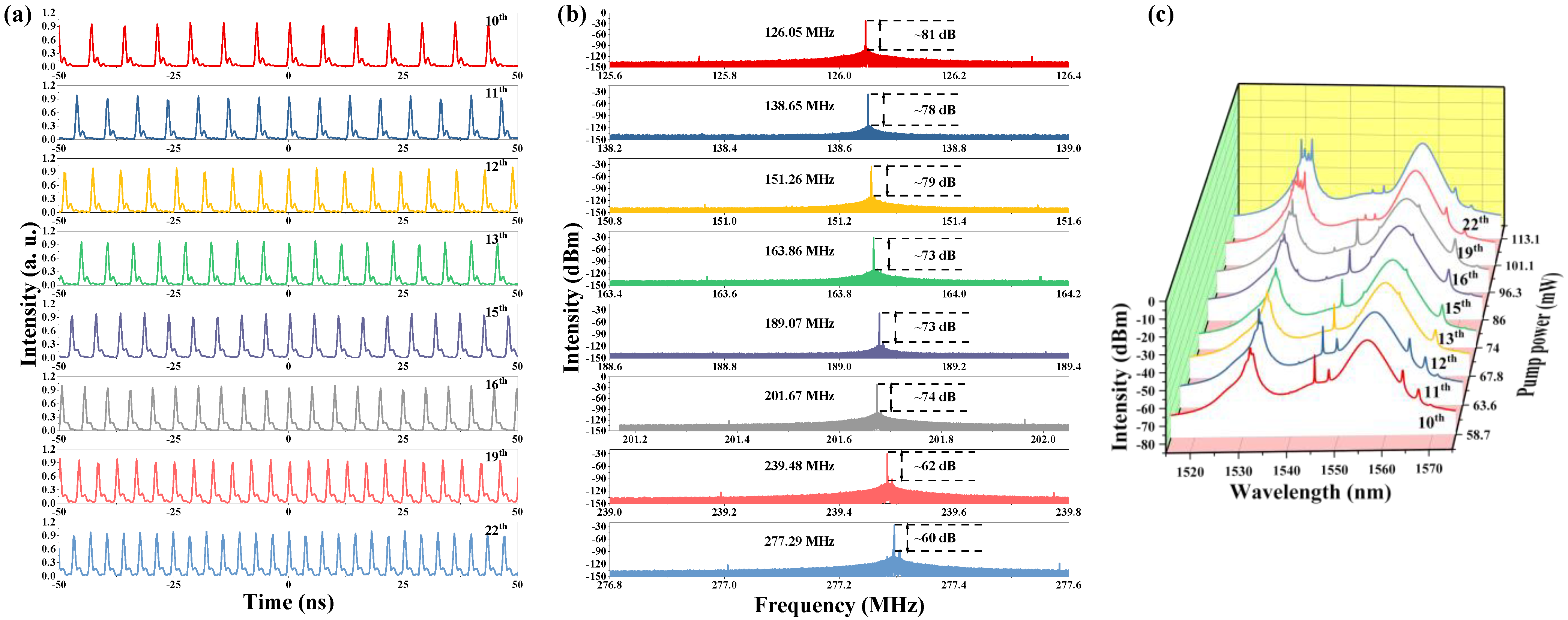
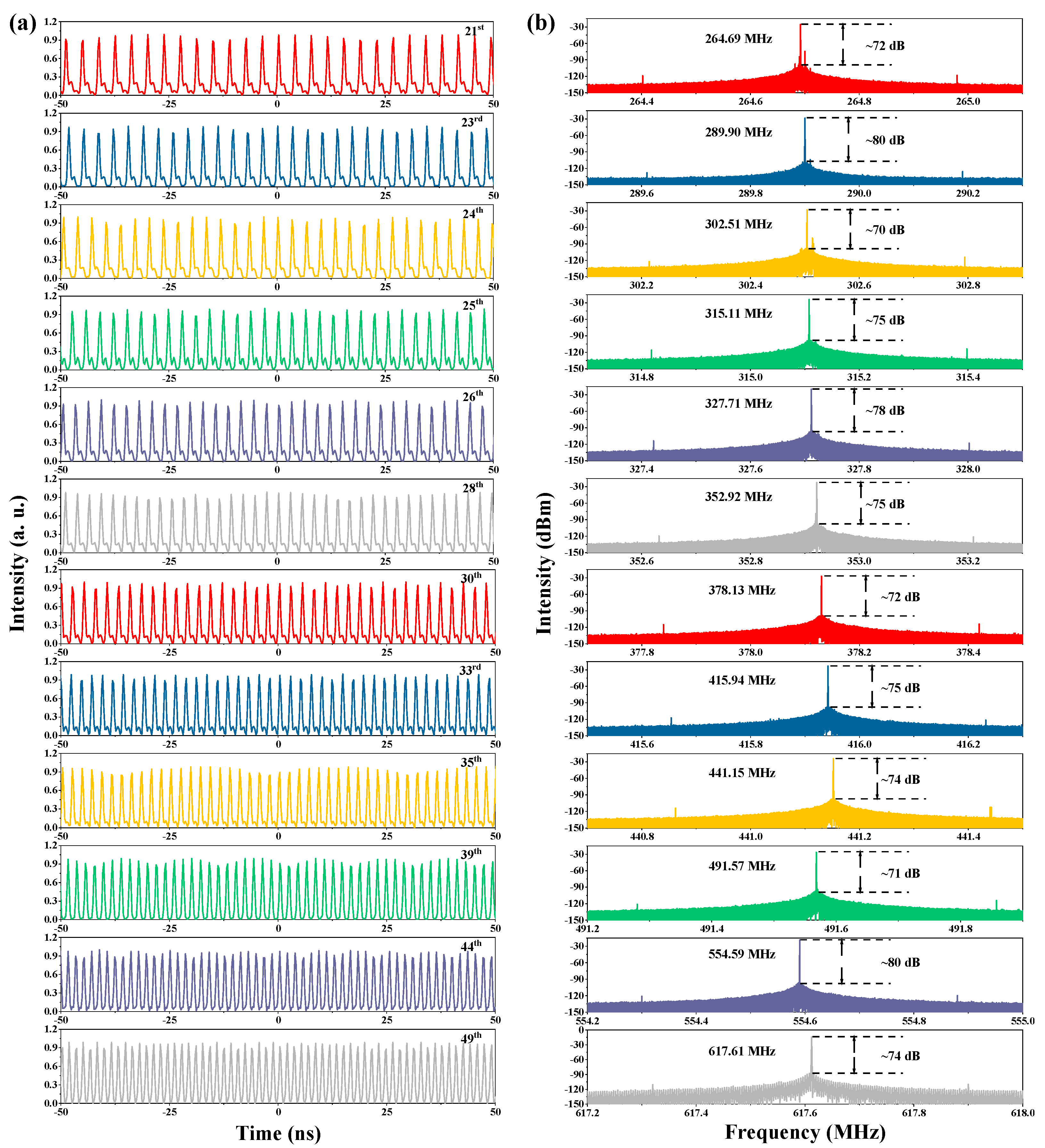
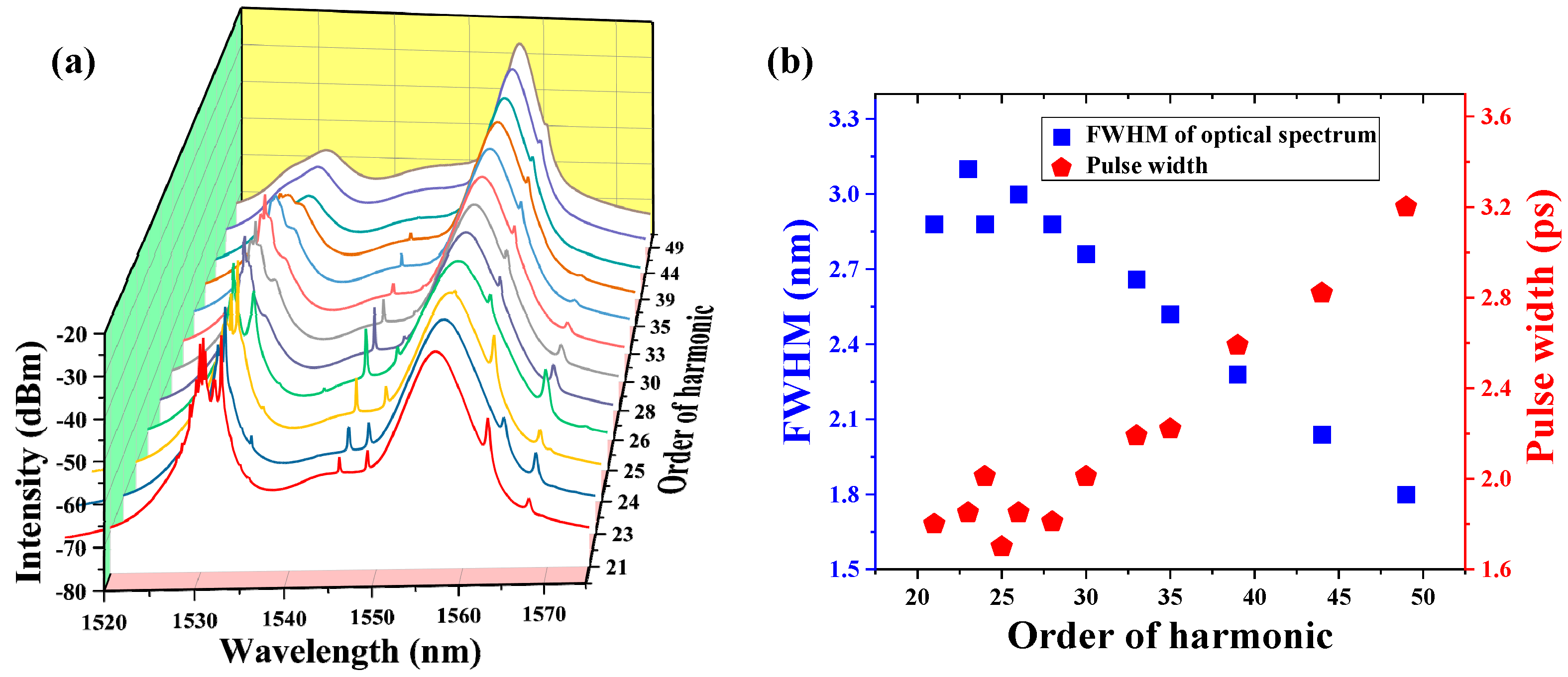
| Materials | Preparation Method | MD (%) | SI (MW/cm2) | NSL (%) | SNR (dB) | Threshold (mW) | Ref. |
|---|---|---|---|---|---|---|---|
| Graphene | CVD | 2.7 | - | - | 64 | 47 | [52] |
| ME | 3.6 | 0.08 | 44.2 | 70 | 38 | [53] | |
| Bi2Te3 | LPE | 4.8 | - | 73.4 | 60 | 80 | [54] |
| Bi2Se3 | Polyol | 98 | 0.49 GW/cm2 | - | - | 65 | [55] |
| Sb2Te3 | LPE | 3.9 | 106 | 87 | 74 | 44 | [56] |
| BP | ME | 0.6 | - | - | 65 | 80 | [57] |
| LPE | 9 | 25 | - | 50 | 30 | [58] | |
| WS2 | PLD | 7.8 | 189 | 25.7 | 64 | 65 | [59] |
| MoS2 | MSD | 19.48 | 4.137 | 38.53 | 75 | 40 | [60] |
| WSe2 | LPE | 0.5 | - | 47.2 | - | 35 | [61] |
| MoSe2 | LPE | 0.8 | - | 52 | 52 | 30.7 | [62] |
| Ti3C2Tx | LPE | 0.96 | 256.9 | 73.5 | 71 | 146 | [63] |
| Antimonene | LPE | 9 | 1.3 GW/cm2 | 9 | - | 130 | [36] |
| Bismuthene | LPE | 2.03 | 30 | 82.5 | 55 | 153 | [64] |
| Tellurene | LPE | 5.06 | 34.3 | 58.6 | 55 | 85 | [21] |
| Cr2Si2Te6 | LPE | 10.7 | 28.6 | 15.78 | 81 | 15.1 | ours |
Disclaimer/Publisher’s Note: The statements, opinions and data contained in all publications are solely those of the individual author(s) and contributor(s) and not of MDPI and/or the editor(s). MDPI and/or the editor(s) disclaim responsibility for any injury to people or property resulting from any ideas, methods, instructions or products referred to in the content. |
© 2023 by the authors. Licensee MDPI, Basel, Switzerland. This article is an open access article distributed under the terms and conditions of the Creative Commons Attribution (CC BY) license (https://creativecommons.org/licenses/by/4.0/).
Share and Cite
Xu, N.; Shang, X.; Sun, S.; Yang, F.; Fan, W.; Zhang, H.; Li, D. Low-Threshold, Multiple High-Order Harmonics Fiber Laser Employing Cr2Si2Te6 Saturable Absorber. Nanomaterials 2023, 13, 1038. https://doi.org/10.3390/nano13061038
Xu N, Shang X, Sun S, Yang F, Fan W, Zhang H, Li D. Low-Threshold, Multiple High-Order Harmonics Fiber Laser Employing Cr2Si2Te6 Saturable Absorber. Nanomaterials. 2023; 13(6):1038. https://doi.org/10.3390/nano13061038
Chicago/Turabian StyleXu, Nannan, Xinxin Shang, Shuo Sun, Fuhao Yang, Weiyu Fan, Huanian Zhang, and Dengwang Li. 2023. "Low-Threshold, Multiple High-Order Harmonics Fiber Laser Employing Cr2Si2Te6 Saturable Absorber" Nanomaterials 13, no. 6: 1038. https://doi.org/10.3390/nano13061038
APA StyleXu, N., Shang, X., Sun, S., Yang, F., Fan, W., Zhang, H., & Li, D. (2023). Low-Threshold, Multiple High-Order Harmonics Fiber Laser Employing Cr2Si2Te6 Saturable Absorber. Nanomaterials, 13(6), 1038. https://doi.org/10.3390/nano13061038







